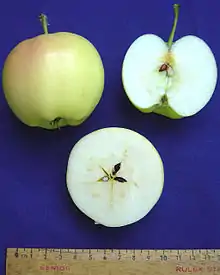PRI disease resistant apple breeding program
The PRI disease resistant apple breeding program is a joint project of the Purdue University, Rutgers University, and the University of Illinois, to breed apple cultivars to be resistant to apple scab. PRI stands for 'P'urdue, 'R'utgers and 'I'llinois.[1]
Formation
It was L. Fredric Hough, then a graduate student at the University of Illinois that studied the papers of C. S. Crandall that carried out intensive studies early in the 20th century, of crosses between the cultivated apples and crab apples, to be scab resistant.[2] However, Crandall didn't see any fruits of his investigations, and if not Hough, all his collection and experiments would be lost.[3] Hough's paper was published in 1944, and led to the 1945 collaboration with J. Ralph Shay. Hough then relocated to Rutgers and the collaborative effort was extended there.[2]
The program
The modified backcross breeding strategy used cultivated apple with recurrent parents from selected susceptible members of the wild ancestral genus malus. Several Malus species were screened and utilized to incorporate their resistance factors into the more advanced pomological backgrounds.[2]
Success

By 2000, the PRI have already released a total of eighteen apple cultivars, containing the scab-resistant Vf gene derived from Malus floribunda 821. Fifty-some PRI germplasm cultivars have also been released worldwide.[2]
References
- About PRI
- ISHS
- "2002 Newsletter" (PDF). Archived from the original (PDF) on 2014-12-23. Retrieved 2014-12-23.
